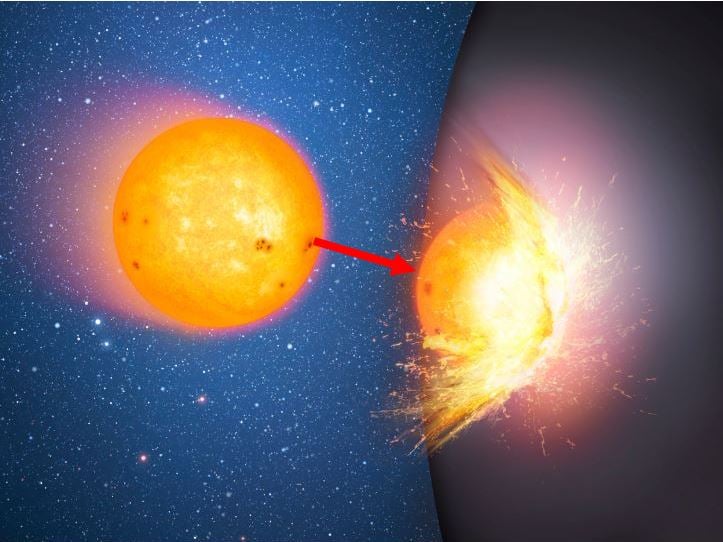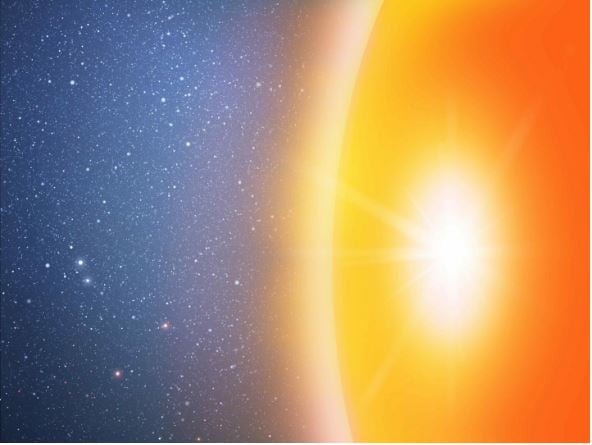Black holes crush matter into nothing, say scientists from Harvard University and the University of Texas at Austin, after putting a basic principle to the test. Some supermassive black holes swallow entire stars whole – in one go – making all their matter vanish completely.
When a supermassive black hole pulls in a star and gobbles it, the tidal effects on the star are negligible, scientists say.
The majority of scientists agree that black holes – celestial entities of such colossal gravity that nothing can escape their grip – are surrounded by an event horizon. An event horizon is a notional boundary around a black hole beyond which nothing – not even light or any type of radiation – can escape. It is a point of no return.
 An artist’s impression of a star crossing a supermassive black hole’s event horizon. This black hole is so huge and massive that there are hardly any tidal effects on the star – it is swallowed whole. This illustration does not show the effects of gravitational lensing distorting the star’s light. (Image: adapted from cfa.harvard.edu)
An artist’s impression of a star crossing a supermassive black hole’s event horizon. This black hole is so huge and massive that there are hardly any tidal effects on the star – it is swallowed whole. This illustration does not show the effects of gravitational lensing distorting the star’s light. (Image: adapted from cfa.harvard.edu)
The moment matter gets near enough to a black hole, it will never escape – it will be sucked in. Even though scientists believe that event horizons exist, nobody has been able to prove it.
Pawan Kumar, a professor of astrophysics at The University of Texas at Austin, and colleagues wrote about their study and findings in the prestigious journal Monthly Notices of the Royal Astronomical Society in an article titled ‘Stellar disruption events support the existence of the black hole event horizon’.
“Our whole point here is to turn this idea of an event horizon into an experimental science, and find out if event horizons really do exist or not.”
Supermassive black holes or giant spheres?
Scientists say that nearly all galaxies have supermassive black holes at their heart. However, some theorists believe that something else is there instead – not a black hole, but an even more bizarre and enigmatic supermassive object that has somehow managed to avoid gravitational collapse to a singularity with an event horizon around it.
This notion is based on Einstein’s theory of gravity.
 This is the FIRST in a sequence of two artist´s illustrations showing a huge, massive sphere in the center of a galaxy, instead of a supermassive black hole. In this image, the star moves towards and then crashes into the sphere’s hard surface, flinging out debris. The impact heats up the site of the collision. (Image: adapted from cfa.harvard.edu)
This is the FIRST in a sequence of two artist´s illustrations showing a huge, massive sphere in the center of a galaxy, instead of a supermassive black hole. In this image, the star moves towards and then crashes into the sphere’s hard surface, flinging out debris. The impact heats up the site of the collision. (Image: adapted from cfa.harvard.edu)
The singularity itself has no surface area, it is just a notional boundary. The non-collapsed giant object, however, would have a hard surface.
Therefore, whatever matter it pulls in, such as a star, would not actually disappear into a black void, but would hit this hard surface and be destroyed.
Prof. Jumar, Wenbin Lu, his graduate student, and Ramesh Narayan, a theorist from the Harvard-Smithsonian Center for Astrophysics, devised a test to determine whether this idea of super-massive objects with a hard surface and event horizons is correct.
Regarding hard surfaces and event horizons, Prof. Kumar explained:
“Our motive is not so much to establish that there is a hard surface, but to push the boundary of knowledge and find concrete evidence that really, there is an event horizon around black holes.”
The scientists determined what a telescope would observe when a star struck the hard surface of a supermassive object at the center of a galaxy: the gas of the star would envelope the object, shining for several months, or maybe even years.
The moment they knew what to look for, Prof. Kumar and team calculated how often this should be observed in the nearby universe, that is, if the hard-surface theory is correct.
 The SECOND artist’s impression. In this one you can see a huge sphere in the center of the galaxy, after a star crashed into it. The event has generated an enormous amount of heat and a significant increase in the brightness of the sphere. Such flares in the center of galaxies have not been observed, which means that this hypothetial scenario is nearly completely ruled out. (Image: cfa.harvard.edu)
The SECOND artist’s impression. In this one you can see a huge sphere in the center of the galaxy, after a star crashed into it. The event has generated an enormous amount of heat and a significant increase in the brightness of the sphere. Such flares in the center of galaxies have not been observed, which means that this hypothetial scenario is nearly completely ruled out. (Image: cfa.harvard.edu)
Lu said:
“We estimated the rate of stars falling onto supermassive black holes. Nearly every galaxy has one. We only considered the most massive ones, which weigh about 100 million solar masses or more.”
“There are about a million of them within a few billion light-years of Earth.”
They then gathered and studied data from the archives of Pan-STARRS, a 1.8-meter telescope in Hawaii that had recently completely a project to survey half of the sky’s northern hemisphere.
Over a period of three-and-a-half years, the telescope scanned the area repeatedly, looking for ‘transients’ – celestial objects that glow for a short period and then fade.
The scientists wanted to find transients with the expected light signature of a star being pulled toward a supermassive object and hitting a hard surface.
No evidence of transients hitting hard surface
Lu said:
“Given the rate of stars falling onto black holes and the number density of black holes in the nearby universe, we calculated how many such transients Pan-STARRS should have detected over a period of operation of 3.5 years. It turns out it should have detected more than 10 of them, if the hard-surface theory is true.”
They did not find any.
“Our work implies that some, and perhaps all, black holes have event horizons and that material really does disappear from the observable universe when pulled into these exotic objects, as we’ve expected for decades. General Relativity has passed another critical test.”
Kumar, Lu and Narayan would like to improve the test by looking at the observations of an ever larger telescope. This time using the 8.4-meter Large Synoptic Survey Telescope (LSST), which is currently under construction in Chile.
LSST will make repeated surveys of the sky over a specified period, just like Pan-STARRS did, revealing transients. However, this time with considerably greater sensitivity.
